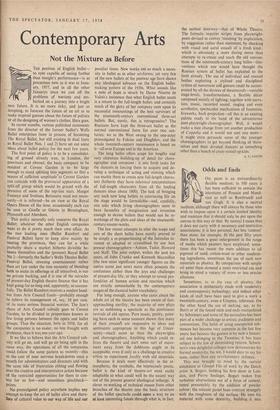Odds and Ends
Ott., paint is an extraordinarily flexible medium; in 500 years it has been sufficient to contain the intentions of Poussin and Mond- rian as well as Rembrandt and van Gogh. It is also a neutral medium, although there will always be those who wish to impose upon it a certain limited identity and maintain that it should only be put upon the canvas in this way or that. By neutral I mean that it does not carry with it necessary and restrictive associations; it is less personal, has less 'content' than stone, for example. Iii•the past fifty years there has been a great enlargement in the range of media which painters have employed; some- times this has meant the mere addition to oil pigment of sand, cotton-wool or other moderat- ing ingredients, sometimes the use of such new materials as plastics. By comparison with simple oil paint these demand a more restricted use and bring to mind a variety of more or less precise allusions.
Sometimes, as in the case of plastics, the association is deliberately made with modernity and contemporary technology; and indeed other kinds of stuff have been used to give a work a twentieth-century. even a Utopian, reference. On the other hand the use of sacking, say, as by Burri or of the found odds and ends manipulated by Schwitters and some of the surrealists has been part of a wider challenge to artistic traditions and conventions. The habit of using unexpected sub- stances has become very common in the last few years, but because the gesture is by now a histori- cal one belonging to the Twenties, it has been subject to the law of diminishing returns. Schwit- ters's own delightful collages now demonstrate his formal sensitivity, his wit, I would dare to say his taste, rather than any revolutionary defiance.
This was brought to mind by the current exhibition at Gimpel Fils of work by the Dutch artist A. Bogart, holding his first show in Lon- don, and Pierre Soulages. Bogart makes free turbulent abstractions out of a form of cement, tinted presumably by the addition of powder colour; the reticent pastel hues contrast strangely with the roughness of the surface. He uses his material with some dexterity, building, it into
heaps which even when solid seem to flow slug- gishly like a dead lava stream. Inevitably these pictures are largely about the material and, after the first small shock occasioned by its use, lead one to see in him a pleasant, sensitive colourist perched on a technical device. By the beginning of 1958, more than a generation after. Dadaism and at a time when new technical recipes are so common, the unfriendly question occurs : 'What next?' for there is really not much difference be- tween searching for some material which has not previously been used and painting some object which has not been exploited before. Soulages- and here is an excellent opportunity for his admirers to buy cheap—is not represented on this occasion by oil paintings, but by lithographs and engravings which show the direct and simple treatment characteristic of his other pictures. How enormously the work of this painter benefits from their direct use of neutral materials which in the hand of an authoritative artist such as this obstinately refuse to wear out.
BASIL TAYLOR































 Previous page
Previous page